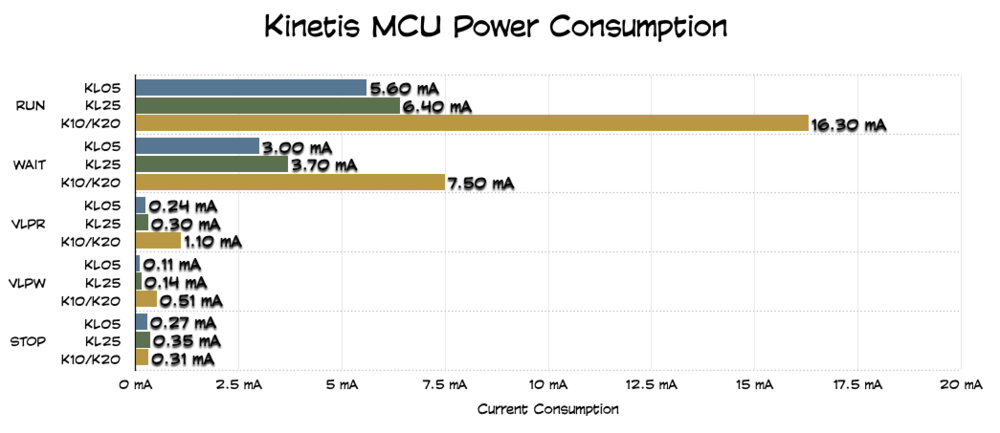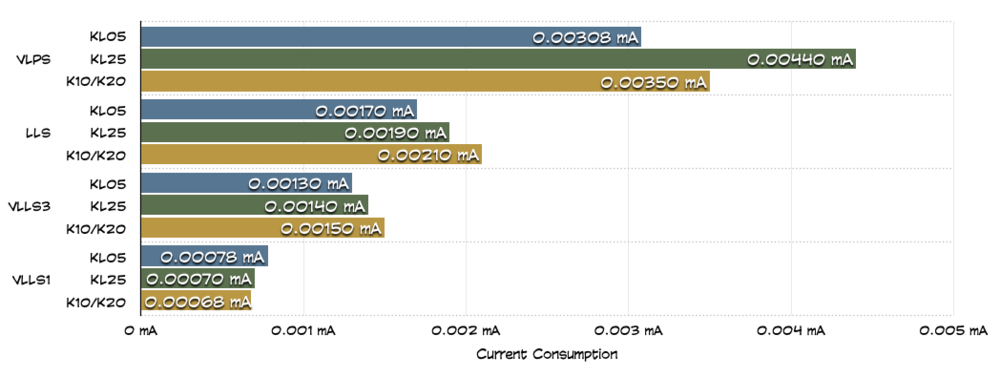Kinetis K and L Series Power Consumption
2013-11-13
While considering a new microcontroller to use, I looked at the power consumption figures for the Freescale Kinetis K and L Series. Having some experience with various MSP430 MCUs, I am used to shaving off microamps and running systems on battery power, sometimes for years.
While the real answer can only be gotten with a real setup, one can get some preliminary information from the datasheets. And I found some surprises lurking there.
I was mostly interested in comparing three MCUs: KL05, KL25 (basically a KL05+USB) and the K20. The K10 which appears in the figures can be thought of as the K20 without USB, and I didn't expect its power figures to be any different from the K20.
The ARM Cortex M0+ has a range of power modes, so comparisons aren't easy. I left out those that basically amount to a full power-down (losing the contents of the RAM). The numbers do not include analog supply current, and are taken at 3V, 25C. The RUN values are at full core frequency (48MHz) with a while(1) loop executing from flash. VLPR and RUN values are with peripheral clocks enabled. Let's look at the first four modes:

As expected, the Cortex M4 core draws significantly more current when running at full speed. About three times more than Cortex M0+, in fact. Note that this doesn't necessarily mean the final product will use more power — if you draw three times more current, but get your computations done three times as fast, you're basically even.
Note what begins to happen in STOP mode, though. The power draw for all chips is nearly the same. Continuing on into the lower-power modes (note the change of scale to 5µA max):

Apart from the strange discrepancy with KL25 in VLPS mode, all numbers are nearly identical.
This is not something I expected — although in retrospect, it makes sense: a stopped core and stopped peripherals consume little to no current, and you can stop nearly everything on all MCUs. Still, this has some real-life implications.
My takeaway from this is:
if your application spends most time in deep sleep modes, then it doesn't really matter which MCU you choose, from the power consumption point of view they are nearly the same,
if you use the CPU a lot, the choice isn't at all clear, and will really depend on the application and its computation patterns.
For comparison, let's look at the MSP430F5510, a chip comparable (from the application point of view) with the KL25, though the CPU is significantly less powerful. Values are in mA, taken at 3V, 25C, RUN values at full frequency (25MHz) running from flash:

The interesting fact here is that the F5510 at 25MHz running code consumes about as much current as the KL05 or KL25 running at 48MHz. ARM Cortex M0+ really is a very power efficient core. It makes sense: the MSP430 is a rather old design. But note how years of experience allow TI to achieve the impressive LPM0 number: 83µA. LPM0 is the lightest sleep mode on the MSP430, roughly comparable to WAIT mode (core stopped, peripheral clocks active, ability to wake up on any interrupt). When you get down to deep-sleep modes (LPM3), the numbers become more comparable.
Take all this with a grain of salt, as it is only based on datasheet numbers. Still, I found the data interesting and worth sharing.